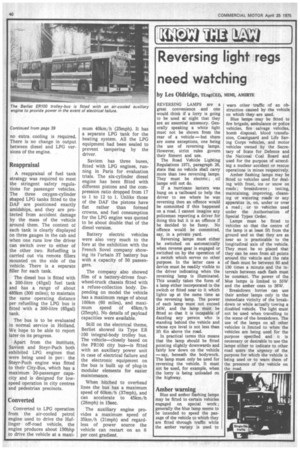Reversing light regs need watching
Page 42

If you've noticed an error in this article please click here to report it so we can fix it.
by Les Oldridge, TEng(CEI), MIMI, AMIRTE REVERSING LAMPS are a great convenience and one would think if a lorry is going to be used at night that they are an essential accessory. Generally speaking a white light must not be shown from the rear of a vehicle —but there are some exceptions, one being the use of reversing lamps. However, strict rules govern their fitment and use.
The Road Vehicle Lighting Regulations 1971, paragraph 26, state that no vehicle shall carry more than two reversing lamps. They must be electric ; oil lamps will not do.
If a hurricane lantern was hung on a tailboard to help the driver to see where he was reversing then an offence would be committed if this happened on a road. I cannot imagine any policeman reporting a driver for doing this but it is an offence if he decided to be fussy. No offence would be committed, say, in a private yard.
Reversing lamps must either be switched on automatically when reverse gear is engaged or switched on by the operation of a switch which serves no other purpose. In the latter case a device must be readily visible to the driver indicating when the reversing lamp is illuminated. This usually takes the form of a lamp either incorporated in the switch or fitted near to it which lights up at the same time as the reversing lamp. The power of each lamp must not exceed 24W, and the lamp must be fitted so that it is incapable of dazzling any person who is standing behind the vehicle and whose eye level is not less than 3ft 6in 'above the road.
In practical terms this means that the lamp should be fitted pointing slightly downwards and fairly low down on the vehicle — say, beneath the bodywork. The lamp must only be used for reversing the vehicle. It must not be used, for example, when the lorry is being unloaded on the highway.
Amber warning
Blue and amber flashing lamps may be fitted to certain vehicles engaged on special work ; generally the blue lamp seems to be intended to speed the passage of the vehicle to which they are fitted through traffic while the amber variety is used to
warn other 'traffic of an obstruction caused by the vehicle on which they are used.
Blue lamps may be fitted to fire brigade, ambulance or police vehicles, fire salvage vehicles, bomb disposal, blood transfusion, Coastguard and Life Saving Corps vehicles, and motor vehicles owned by the Secretary of State for Defence and the National Coal Board and used for the purpose of attending a nuclear accident or rescue operations in mines respectively.
Amber flashing lamps may be fitted to vehicles used for dealing with frost, ice or snow on
roads ; breakdowns ; testing, maintaining, improving, cleansing or watering roads or any apparatus in, on, under or over a road ; or to vehicles used under the Authorisation of Special Types Order.
Lamps must be fitted to vehicles so that the centre of the lamp is at least 5ft from the ground and so that they are as near as is practicable to the longitudinal axis of the vehicle. They must be so placed that they can be seen from all points around the vehicle and the rate of flash must be between 60 and 150 times a minute and the intervals between each flash must be constant. The power of the blue lamps is limited to 55W and the amber ones to 36W.
Breakdown lorries can use their amber lamps only in the immediate vicinity of the breakdown or while actually towing a disabled vehicle. The light must not be used when 'travelling to the scene of the breakdown. The use of the lamps on all other vehicles is limited to when the vehicles are being used for the purpose specified and it is necessary or desirable to use the lamps either to indicate to other road users the urgency of the purpose for which the vehicle is being used or to warn them of the presence of the vehicle on the road.




















































































